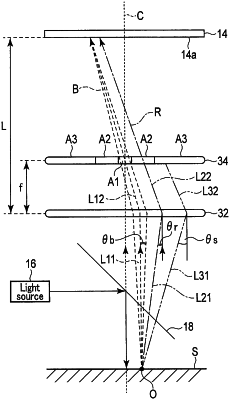| CPC G01N 21/8806 (2013.01) [G01N 21/94 (2013.01); G01N 2021/8845 (2013.01)] | 9 Claims |

|
1. An optical inspection method for a surface state of a subject comprising:
acquiring a color vector with a pixel value of each color for each pixel corresponding to a wavelength spectrum in a color coordinate system of n dimensions (n is a natural number equal to or larger than 1), which is equal to or smaller than a number of a plurality of color channels of pixels of an image sensor, with optical imaging using a wavelength spectrum selection portion that selectively allows a plurality of wavelength spectra different from one another from a surface of the subject to pass; and
discriminating the surface state of the subject corresponding to said each pixel based on a direction of the color vector in the color coordinate system,
wherein
when a color vector corresponding to a specular reflection direction or a first scattering direction from the surface of the subject is represented as a first reference vector and a color vector corresponding to the specular reflection direction or a second scattering direction different from the first scattering direction is represented as a second reference vector,
the discriminating the surface state of the subject includes discriminating a type of the surface according to whether the direction of the color vector is close to the first reference vector or close to the second reference vector.
|
|
4. A non-transitory storage medium storing an optical inspection program for a surface state of a subject, the optical inspection program causing a computer to implement:
acquiring a color vector with a pixel value of each color for each pixel corresponding to a wavelength spectrum in a color coordinate system of n dimensions (n is a natural number equal to or larger than 1), which is equal to or smaller than a number of a plurality of color channels of pixels of an image sensor, with optical imaging using a wavelength spectrum selection portion that selectively allows a plurality of wavelength spectra different from one another from a surface of the subject to pass; and
discriminating the surface state of the subject corresponding to said each pixel based on a direction of the color vector in the color coordinate system,
wherein
when a color vector corresponding to a specular reflection direction or a first scattering direction from the surface of the subject is represented as a first reference vector and a color vector corresponding to the specular reflection direction or a second scattering direction different from the first scattering direction is represented as a second reference vector,
in the processor configured to discriminate the surface state of the subject, the processor is configured to discriminate a type of the surface according to whether the direction of the color vector is close to the first reference vector or close to the second reference vector.
|
|
5. A processing device used for an optical inspection of a surface state of a subject, the processing device including a processor being configured to:
acquire a color vector with a pixel value of each color for each pixel corresponding to a wavelength spectrum in a color coordinate system of n dimensions (n is a natural number equal to or larger than 1), which is equal to or smaller than a number of a plurality of color channels of pixels of an image sensor, with optical imaging that selectively allows a plurality of wavelength spectra different from one another from a surface of the subject to pass; and
discriminate the surface state of the subject corresponding to said each pixel based on a direction of the color vector in the color coordinate system,
wherein
when a color vector corresponding to a specular reflection direction or a first scattering direction from the surface of the subject is represented as a first reference vector and a color vector corresponding to the specular reflection direction or a second scattering direction different from the first scattering direction is represented as a second reference vector,
in the processor configured to discriminate the surface state of the subject, the processor is configured to discriminate a type of the surface according to whether the direction of the color vector is close to the first reference vector or close to the second reference vector.
|